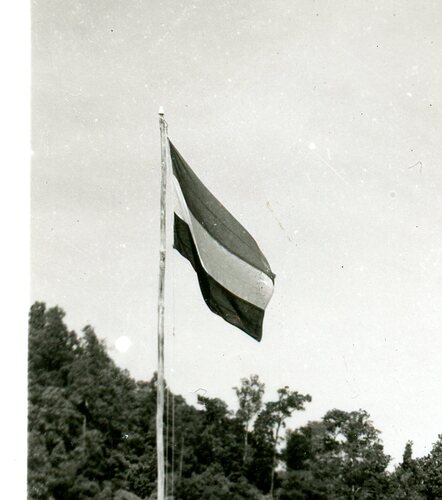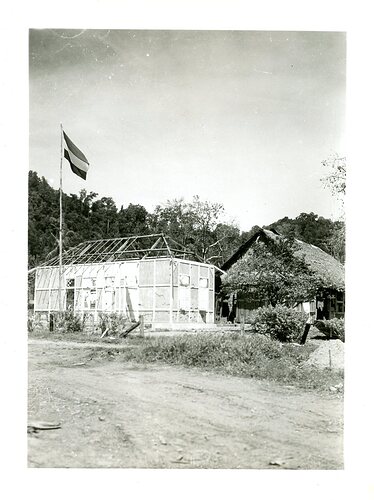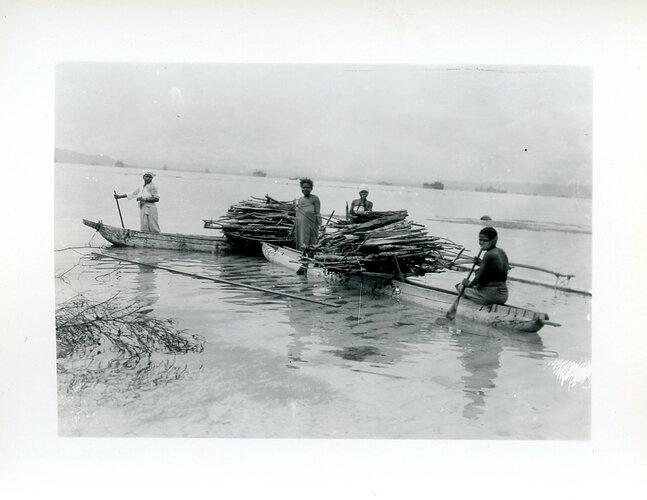Soldier who took this photo was stationed in the Philippines during WWII. However, before he went there he was stationed in another country/island in the Pacific theater and I need help identifying it by knowing what country this flag represents. The natives look like they may be New Guinea natives but I couldn’t find any match with New Guinea and this flag. (but dosen’t mean it can’t still be New Guinea). Can anyone help and tell what you think or know it is?
Without colors, your question is a bit quixotic. You can’t even be sure whether the top bar is a different color than the bottom bar. You’re also making the assumption it is a national flag, as opposed to that of a state, territory, military, school, or something else. It could be a Dutch flag (red on the top, white, then blue on the bottom), due to their colonies (e.g., Dutch New Guinea) in the area. But I believe there were several 3-bar flags in the Pacific at the time. The furl caused by the wind might also be hiding a symbol, though that seems unlikely. For that mater, I’ve seen some examples of the Spanish flag (red-yellow-red) that lacked any symbols, but I don’t know if they were special-purpose or not, or what era they might be from. Spain, of course, colonized the Philippines…
Looks like it might be a Dutch flag. The Dutch East Indies (which is now Indonesia, New Guinea and some other small island countries) where in existence up until Japanese occupation of the Islands in February 1942.
The man in the last photo could be an Australian Aborigine or Melanesian, but the outrigger canoe is typical of Melanesia rather than Australia so that indicates that the photos were taken in Melanesia, which is a vast area from Dutch New Guinea eastwards to the Solomons, Vanuatu, etc.
The bars go the wrong way for the French flag, so that rules out New Caledonia, unless it was some other sort of flag there.
Vanuatu was jointly administered by the French and British. I don’t know if they came up with a flag for Vanuatu, but I’m inclined to doubt it.
Papua was Australian territory during WWII and didn’t have its own flag. The eastern part of New Guinea was Australian mandated territory during WWII and presumably didn’t have its own flag.
Fiji was a British colony, so it probably didn’t have its own flag. I don’t know if American troops were stationed there.
Some of the Solomon Islands were a British Protectorate and others were under Australian control as mandated territories, so presumably they didn’t have their own flag.
Thanks everyone for your responses. Rising Sun, how can really tell the difference between New Guinea natives and Melanesian natives? I have looked online and can’t seem to find a difference. Both seem to be popular for outrigger canoes. Are there any other distinctions you see that led you to that answer?
[COLOR=“blue”]Thanks everyone for your responses. Rising Sun, how can really tell the difference between New Guinea natives and Melanesian natives? I have looked online and can’t seem to find a difference. Both seem to be popular for outrigger canoes. Are there any other distinctions you see that led you to that answer? [/COLOR]
I think you misunderstood my post.
New Guineans are Melanesian. During WWII that included the New Guineans in the western Dutch part of New Guinea and in the eastern Australian part.
oh okay i get it now. if that is in fact a dutch flag than chances are the pictures were taken in West Papua, New Guinea. thank you
If it’s the Dutch flag, and if the photo was taken by an American serviceman, it was probably taken after the American / Australian advances in 1944 and most probably the American landing at Hollandia in Dutch New Guinea in April 1944 or subsequent American landings westward from there.
However, it’s possible that it could have been taken early in 1942 when the short-lived ABDA (American British Dutch Australian) command and forces were active in the region. I think that American activity anywhere near New Guinea then was limited to USN and perhaps USAAF forces, but perhaps there was the odd American land force.




